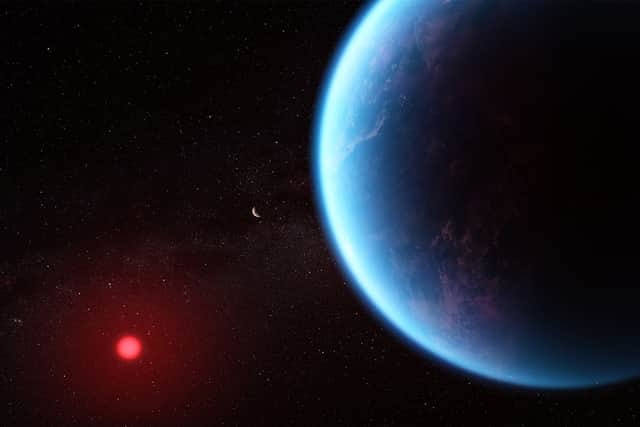K2-18b: Nasa finds distant exoplanet 8 times the size of Earth and hints at life molecule
and live on Freeview channel 276
A planet around 120 light years away from Earth may have water-covered surfaces, making it a candidate to support life.
The exoplanet, known as K2-18b, is more than eight times the size of Earth, and orbits a cool dwarf star called K2-18 - within the constellation of Leo and sits within the habitable zone.
Advertisement
Hide AdAdvertisement
Hide AdThis ground-breaking discovery was first seen by Nasa's James Webb Telescope made possible by the Hubble Space Telescope.


K2-18b belongs to a unique class of exoplanets known as "Hycean" planets - which possess hydrogen-rich atmospheres.
The exoplanets with the sizes between Earth and Neptune are not seen in out solar system, making their characteristics a mystery for astronomers.
Nikku Madhusudhan, an astronomer at the University of Cambridge and lead author of the study, said: "Our findings underscore the importance of considering diverse habitable environments in the search for life elsewhere.
Advertisement
Hide AdAdvertisement
Hide Ad"Traditionally, the search for life on exoplanets has focused primarily on smaller rocky planets, but the larger Hycean worlds are significantly more conducive to atmospheric observations."
Carbon dioxide and methane K2-18b has been detected in the atmosphere as well as the absence of ammonia suggests K2-18 b features a hydrogen-rich atmosphere above a potential water ocean, scientists said.
Nasa, says: “A Hycean exoplanet, one which has the potential to possess a hydrogen-rich atmosphere and a water ocean-covered surface”.
The space agency said that its observations of the chemical make-up of the planet’s atmosphere suggested the possibility of an ocean world. “The abundance of methane and carbon dioxide, and shortage of ammonia, support the hypothesis that there may be a water ocean underneath a hydrogen-rich atmosphere in K2-18 b,” it said.
Advertisement
Hide AdAdvertisement
Hide AdThe telescope's initial observations also suggested the presence of dimethyl sulfide (DMS), a molecule primarily associated with microbial life such as marine phytoplankton on Earth, suggesting the possibility of biological activity on K2-18 b.
But Mr Madhusudhan noted "more observations are needed to determine whether it is in fact DMS that we're seeing".
The research is soon to be published in The Astrophysical Journal Letters, with the team intending to conduct further work.
"Our ultimate goal is the identification of life on a habitable exoplanet, which would transform our understanding of our place in the universe," Mr Madhusudhan concluded.
"Our findings are a promising step towards a deeper understanding of Hycean worlds in this quest."
Comment Guidelines
National World encourages reader discussion on our stories. User feedback, insights and back-and-forth exchanges add a rich layer of context to reporting. Please review our Community Guidelines before commenting.
